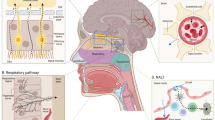Abstract
A dihydropyridine-based chemical delivery system (CDS), intended to improve drug delivery to the brain, was investigated with a series of analogues of the anticonvulsant stiripentol. In vitro experiments demonstrated that the rates of hydrolysis of the corresponding pyridinium conjugates were influenced markedly by small changes in the structure of the drug moiety to be released. Thus, allylic esters were hydrolyzed rapidly to drug in all aqueous media, while the analogous saturated esters and an allylic amide derivative were almost totally stable. The mechanism of hydrolysis, which is particular to this series of CDS conjugates, appeared to occur via ionization to a resonance-stabilized carbocation intermediate. The same CDS compounds were investigated in vivo and compared to the corresponding drugs after intravenous administration. Only those CDS compounds that were found to hydrolyze in vitro released appreciable amounts of drug in vivo. Prolonged release of the drug from the CDS in the brain could be demonstrated for these compounds, but the gain in the ratio of brain-to-plasma AUC when the CDS was administered depended on the innate distribution characteristics of the drug. Thus, the drug D3, which had a high brain-to-plasma AUC ratio, did not show an improvement in this ratio when administered as CDS3. In contrast, stiripentol with a poor brain-to-plasma AUC ratio showed a two- to threefold increase in this ratio when administered as a CDS. These investigations highlight the need for a thorough understanding of the mechanism of drug release and the importance of the pharmacokinetic properties of the drug in designing a carrier system for delivery of drugs to the brain.
Similar content being viewed by others
REFERENCES
A. Goodman Gilman, L. S. Goodman, T. W. Rall, and F. Murad. The Pharmacological Basis of Therapeutics, 7th ed., Macmillan, New York, 1985.
W.-M. Wu, E. Pop, E. Shek, and N. Bodor. Brain specific delivery systems for beta-lactam antibiotics. In vitro and in vivo studies of some dihydropyridine and dihydroisoquinoline derivatives of benzylpenicillin in rats. J. Med. Chem. 32:1782–1788 (1989).
N. Bodor and M. Brewster. Problems of delivery of drugs to the brain. Pharmacol. Ther. 19:337–389 (1983).
N. Bodor. Targeting of drugs to the brain. Methods Enzymol. 112:381–396 (1985).
N. Bodor. Redox drug delivery systems for targeting drugs to the brain. Ann. N.Y. Acad. Sci. 507:289–306 (1987).
N. Bodor and H. H. Farag. Improved delivery through biological membranes. XIV. Brain specific, sustained delivery of testosterone using a redox delivery system. J. Pharm. Sci. 73:385–389 (1984).
W. R. Anderson, J. W. Simpkins, M. E. Brewster, and N. S. Bodor. Evidence for prolonged suppression of stress-induced release of adrenocorticotropic hormone and corticosterone with a brain enhanced dexamethasone-redox delivery system. Neuroendocrinology 50:9–16 (1989).
M. J. Phelan and N. Bodor. Improved delivery through biological membranes. XXXVII. Synthesis and stability of novel redox derivatives of naproxen and indomethacin. Pharm. Res. 6:667–676 (1989).
G. Mullersman, H. Derendorf, M. E. Brewster, K. S. Estes, and N. Bodor. High-performance liquid chromatographic assay of a central nervous system estradiol chemical delivery system and its application after intravenous administration. Pharm. Res. 5:172–177 (1988).
E. Palamino, D. Kessel, and J. P. Horwitz. A dihydropyridine carrier system for sustained delivery of 2′,3′-dideoxynucleosides to the brain. J. Med. Chem. 32:622–625 (1989).
M. Poisson, F. Huguet, A. Savattier, F. Bakri-Logeais, and G. Narcisse. A new type of anticonvulsant, Stiripentol. Pharmacological profile and neurochemical study. Arzneim.-Forsch. 34:199–204 (1984).
T. A. Moreland, J. Astoin, F. Lepage, F. Tombret, R. H. Levy, and T. A. Baillie. The metabolic fate of stiripentol in man. Drug Metab. Disp. 14:654–662 (1986).
J. Koskikallio. Alcoholysis, acidolysis and redistribution of esters. In S. Patai (ed.), The Chemistry of Carboxylic Acids and Esters, Interscience, New York, 1969, pp. 103–133.
A. Boddy and L. Aarons. Pharmacokinetic and pharmacodynamic aspects of site-specific drug delivery. Adv. Drug Del.Rev. 3:155–164 (1989).
C. A. Hunt, R. D. MacGregor, and R. A. Siegel. Engineering targeted in vivo drug delivery. I. The physiological and physicochemical principles governing opportunities and limitations. Pharm. Res. 3:333–344 (1986).
A. Boddy, L. Aarons, and K. Petrak. Efficiency of drug targeting: Steady-state considerations using a three-compartment model. Pharm. Res. 6:367–372 (1989).
E. Shek, J. Murakami, C. Nath, E. Pop, and N. S. Bodor. Improved anticonvulsant activity of phenytoin by a redox brain delivery system. III. Brain uptake and pharmacological effects. J. Pharm. Sci. 78:837–843 (1989).
Author information
Authors and Affiliations
Rights and permissions
About this article
Cite this article
Boddy, A.V., Zhang, K., Lepage, F. et al. In Vitro and in Vivo Investigations of Dihydropyridine-Based Chemical Delivery Systems for Anticonvulsants. Pharm Res 8, 690–697 (1991). https://doi.org/10.1023/A:1015885530405
Issue Date:
DOI: https://doi.org/10.1023/A:1015885530405




